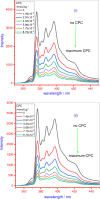Investigation of micellar and interfacial phenomenon of amitriptyline hydrochloride with cationic ester-bonded gemini surfactant mixture in different solvent media
- PMID: 33156844
- PMCID: PMC7647059
- DOI: 10.1371/journal.pone.0241300
Investigation of micellar and interfacial phenomenon of amitriptyline hydrochloride with cationic ester-bonded gemini surfactant mixture in different solvent media
Abstract
Herein, the interaction among the antidepressant drug amitriptyline hydrochloride (AMT) and a green gemini surfactant, ethane-1, 2-diyl bis(N,N-dimethyl-N-tetradecylammoniumacetoxy) dichloride (14-E2-14), via numerous techniques such as tensiometry, fluorimetry, FT-IR and UV-visible spectroscopy in three different media (aqueous 0.050 mol·kg-1 NaCl, 0.50 and 1.0 mol·kg-1 urea) were investigated. AMT is used to treat mental illness or mood problems, such as depression. The aggregation of biologically active ingredients can enhance the bioavailability of hydrophobic drugs. A significant interaction between AMT and 14-E2-14 was detected by tensiometric study as the critical micelle concentration (cmc) of AMT+14-E2-14 is reduced upon an increase of mole fraction (α1) of 14-E2-14. The decrease in cmc indicates the nonideality of studied mixtures of different compositions. Although, employed drug AMT is freely soluble in the aqueous and non-aqueous system but is not hydrophobic enough to act as its carrier. Instead, gemini surfactant formed spherical micelles in an aqueous system and their high solubilization capability, as well as their relatively lower cmc value, makes them highly stable in vivo. The cmc values of AMT+14-E-14 mixtures in all cases were further decreased and increased in NaCl and urea solutions respectively as compared with the aqueous system. Numerous micellar, interfacial, and thermodynamic parameters have been measured by applying various theoretical models. The obtained changes in the physicochemical assets of AMT upon adding of 14-E2-14 are likely to enhance the industrial and pharmaceutical applications of gemini surfactants. The negative interaction parameters (βm and βσ), indicate synergistic attraction is occurring in the mixed systems. The aggregation number (Nagg), Stern-Volmer constant (Ksv), etc. are attained through the fluorescence method, also supporting the attractive interaction behavior of AMT+14-E2-14 mixtures in all solvents. The Nagg was found to increase in the salt solution and decrease in the urea system compared with the aqueous solution. FT-IR and UV-visible analysis also depict the interaction between the constituent alike tensiometry and fluorimetry methods. The results suggested that gemini surfactants may serve as a capable drug delivery agent for antidepressants, improving their bioavailability.
Conflict of interest statement
The authors have declared that no competing interests exist.
Figures







References
-
- Rosen MJ. Surfactants and interfacial phenomena. 3rd ed. New York: Wiley; 2004.
-
- Ren ZH, Huang J, Zheng YC, Lai L, Hu LL. Effect of isopropanol on the micellization of binary mixture containing amino sulfonate amphoteric surfactant in aqueous solution: Mixing with octylphenol polyoxyethylene ether (7). J. Mol. Liquids 2017; 236: 101–106.
-
- Kumar D, Rub MA. Catalytic role of 16-s-16 micelles on condensation reaction of ninhydrin and metal-dipeptide complex. J. Phys. Org. Chem. 2019; 32: e3918.
-
- Kumar D, Rub MA, Role of cetyltrimethylammonium bromide (CTAB) surfactant micelles on kinetics of [Zn(II)-Gly-Leu]+ and ninhydrin. J. Mol. Liquids 2019; 274: 639–645.
Publication types
MeSH terms
Substances
LinkOut - more resources
Full Text Sources
Miscellaneous

